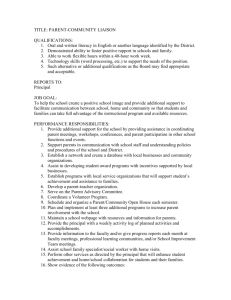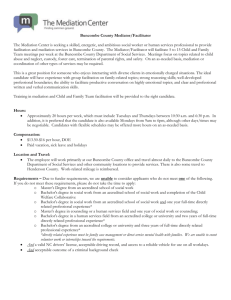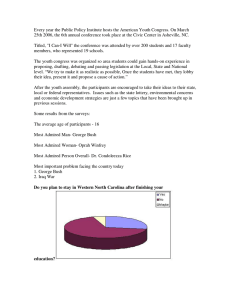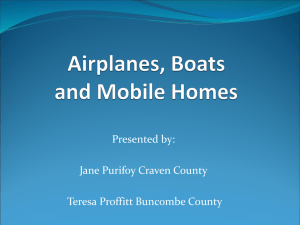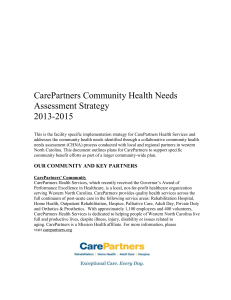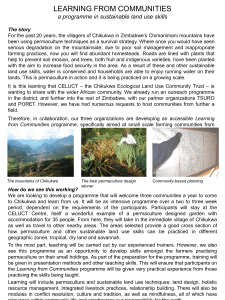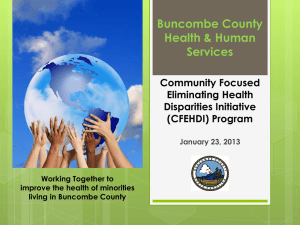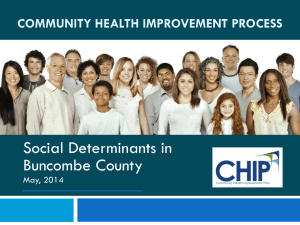Food Action Plan for Asheville and Buncombe County
advertisement
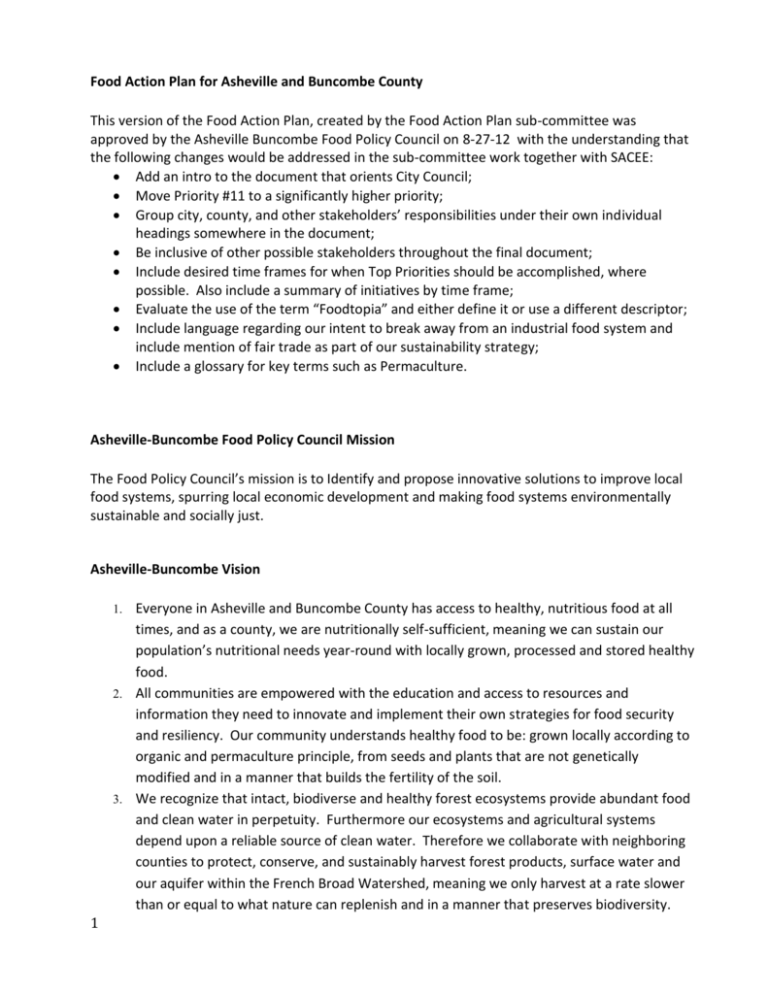
Food Action Plan for Asheville and Buncombe County This version of the Food Action Plan, created by the Food Action Plan sub-committee was approved by the Asheville Buncombe Food Policy Council on 8-27-12 with the understanding that the following changes would be addressed in the sub-committee work together with SACEE: Add an intro to the document that orients City Council; Move Priority #11 to a significantly higher priority; Group city, county, and other stakeholders’ responsibilities under their own individual headings somewhere in the document; Be inclusive of other possible stakeholders throughout the final document; Include desired time frames for when Top Priorities should be accomplished, where possible. Also include a summary of initiatives by time frame; Evaluate the use of the term “Foodtopia” and either define it or use a different descriptor; Include language regarding our intent to break away from an industrial food system and include mention of fair trade as part of our sustainability strategy; Include a glossary for key terms such as Permaculture. Asheville-Buncombe Food Policy Council Mission The Food Policy Council’s mission is to Identify and propose innovative solutions to improve local food systems, spurring local economic development and making food systems environmentally sustainable and socially just. Asheville-Buncombe Vision Everyone in Asheville and Buncombe County has access to healthy, nutritious food at all times, and as a county, we are nutritionally self-sufficient, meaning we can sustain our population’s nutritional needs year-round with locally grown, processed and stored healthy food. 2. All communities are empowered with the education and access to resources and information they need to innovate and implement their own strategies for food security and resiliency. Our community understands healthy food to be: grown locally according to organic and permaculture principle, from seeds and plants that are not genetically modified and in a manner that builds the fertility of the soil. 3. We recognize that intact, biodiverse and healthy forest ecosystems provide abundant food and clean water in perpetuity. Furthermore our ecosystems and agricultural systems depend upon a reliable source of clean water. Therefore we collaborate with neighboring counties to protect, conserve, and sustainably harvest forest products, surface water and our aquifer within the French Broad Watershed, meaning we only harvest at a rate slower than or equal to what nature can replenish and in a manner that preserves biodiversity. 1. 1 Buncombe County’s agriculture-related economy thrives and ensures social and ecological sustainability, meaning we work together to meet universal human needs and to protect and maintain the health, diversity and abundance of life in our bioregion. 5. Everyone enjoys the permanent legal right to food sovereignty - to cultivate, harvest, save seed, process, sell, share and trade food and have access to clean water, air and land to grow that food - in order to thrive and empower his/her resilience. 6. City and County government serve in partnership with the people to maintain and continually regenerate Buncombe County as a national example of Foodtopia through strategic policies, appropriations, programs and mandates. 4. Long Term Goals 1. 2. 3. 4. 5. 6. 7. 2 Establish a baseline of local food access within the next three to six months. a. Inventory nutritional access county-wide. Who does and does not have access to locally grown food and sufficient nutrition and for those who do not, why not? b. Inventory food resources (food growing, processing and storage) county-wide. c. Inventory emergency access within Asheville and county-wide. How much food is available in the event of an interruption to our food supply and how long will it last? Where is it being stored and how is it distributed? How much more food would communities within our county need to grow and store to feed our population for a week in the event of an emergency? Identify and implement ways to increase local food production for local consumption by at least 5% per year over the baseline, with a minimum of 2% of the total being syntheticchemical-free (organic with or without certification) and non-GMO food, and with a goal to be 100% nutritionally self sufficient by 2035. Identify ways to increase access for those who currently do not have it and implement those initiatives to increase food access to those populations by at least 5% per year. Baseline the amount of locally grown food being served in City and County Schools. Develop policies and programs to ensure that all City and County schools serve locally grown food as a minimum of 5% of their total food offerings by the end of the 2014 school year, increasing 5% per year thereafter. Develop a plan and implement it through public-private partnerships to ensure a minimum of a one week’s supply of emergency food for the entire county’s population in any season of the year. Identify economic development opportunities related to agriculture that will enable our region to become nutritionally self-sufficient and economically robust and provide incentives to increase ag-related income by 2% per year over the next 10 years. Track progress toward increased food production, access, and agriculture-related economic development and to report it out to the public and to policy makers regularly. Publish and widely distribute an annual report card on our Food Action Plan vision, goals and priorities as part of a city and county sustainability report. 3 Top Priorities County/ASAP: Create a baseline of quantity and type of food-growing in Buncombe County. 2. County/ASAP: Create a baseline of quantity and type of food processing facilities to ensure long term food access across all communities within Buncombe County. Add two processing facilities in two areas of highest need, if this proves to be . 3. Review the County/City emergency plan to respond to short term food crisis. Look for any desired updates. i. Meet with city, county, and community partner personnel to understand existing emergency plans, as well as food storage capacity and how that compares to Buncombe County’s needs. ii. explore whether we need storage facilities in order to meet long term goal 1.c. explore plans for storage facilities in areas of highest need. iii. Assess emergency food distribution to identify any needed improvements. 4. FPC: Engage farmers in the Food Policy Council to identify their needs and how to help them through policy, programs and economic development planning. 5. County and City: Prioritize local, fresh foods in cafeterias of schools. Implement educational programs by creating curriculum and menus. Promote the adoption of healthy foods and funding for City and County schools, educators, consultants and any difference in expense for sourcing and processing locally grown food. 6. SACEE/City Staff/FPC in collaboration: Evaluate the existing Land Use Policy as it relates to urban and rural agriculture to ensure it supports our long term goals. Evaluate government policy – both local and federal road blocks – and remedy barriers to production and distribution. 7. City and County: Designate funding/staff/CDBG monies to support a "Resilient Neighborhoods" program, to assist neighbors in developing awareness of food security and planning for food shortages, including planting gardens. 8. City: Investigate the potential for a citywide composting program to complement trash and recycling programs and create a central point for community access to compost. FPC/SACEE: Support city efforts by aiding in promotion to related area agencies. 9. City: Support community gardens and urban agriculture through resolutions. Include requirements for GMO Free. Include incentives/programs to support the NC 10% in large institutions. 10. City and county: Open and encourage city- and county-owned parks and greenways to community gardening and ensure any landscape design by firms includes the purpose of growing healthy food, providing nutritional education and involving communities in food security. i. Utilize edible and medicinal landscaping in all public parks and rights of way and set target percentages of land devoted to food production ii. Allow the gleaning and distribution of products from edible trees, plants, etc. in parks and rights of way. iii. Encourage partnerships and volunteerism in park gardens and greenways. 11. City and County: Encourage food distribution in underserved communities by establishing market areas in each neighborhood, based on neighborhood preferences. 1. 4 Encourage mobile markets for low-income communities where desired, especially those in food deserts. Create food mentoring opportunities where wanted. 12. City and County: Incent innovative methods of production (intensive permaculture systems, aquaculture, vertical farming, rooftop gardens, etc.) and include requirements for GMO-free. 13. County/Beacon: Evaluate the need for additional food serving sites for those in need. Engage Parks/Rec with partners such as AB Tech, AIR DINER, GO, MANNA, ABCCM, Salvation Army, and Meals on Wheels to address needs. 14. City: Identify arable city-owned land and issue an RFP for organic, GMO-free food production, with a focus on Permaculture. 5

